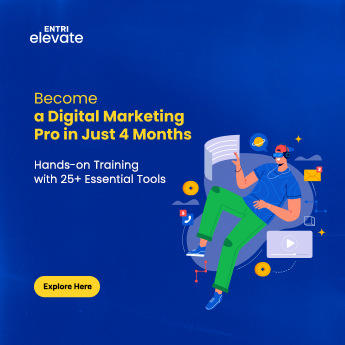Table of Contents
In the fast‑evolving Indian financial services space, Zerodha stands out not just for what it offers (low‑cost trading) but how it reached millions of users without spending big on traditional advertising. In this blog post we’ll explore Zerodha’s marketing campaign and strategy from the ground up, why it works for “normal people”, what digital marketing experts can pick up, and what students aspiring to enter the field should take away. Alongside, we’ll show how learning platforms like the Entri AI‑powered Digital Marketing Course connect perfectly with this strategy.
Setting the Stage: What Zerodha Did
When Zerodha was founded in 2010 by Nithin Kamath and Nikhil Kamath in Bengaluru, the Indian brokerage space was dominated by legacy players, high brokerage costs, and complex user experiences.
Here’s a quick snapshot of the core context:
- Brokerage fees were high, and many small traders felt excluded.
- The process of investing/trading required lots of paperwork and confusing interfaces.
- The marketing spend of incumbents was large; but the gap was in serving new/informal investors and simplifying the path.
Zerodha’s mission was simple: remove barriers (“Zero Rodha” from Sanskrit + English) and make investing accessible.
In doing so, it executed a set of marketing and business moves that created a flywheel of growth more through value and community than paid ads.
Join Our Online Digital Marketing Course & Learn the Fundamentals!
Key Pillars of Zerodha’s Marketing Campaign
1: What is the primary goal of SEO (Search Engine Optimization)?
Let’s unpack the main elements of their marketing strategy that normal people can understand (and digital marketing folk can learn from).
1. Transparent, barrier‑free value proposition
- Zerodha introduced zero brokerage on equity delivery trades, making the value easy to understand.
- The name and branding emphasised “no obstruction” for investors.
Why this matters: For everyday users, the message is clear and compelling—”you don’t pay where others do”. For marketers, this is an example of value innovation (low cost + differentiation).
2. Word‑of‑mouth, referral and community first
- Rather than invest heavily in billboards/television, Zerodha placed focus on user‑referrals and community. According to reports, ~60% of users joined via referrals.
- They built educational content (e.g., the “Varsity” portal) to create trust and engage novices rather than purely pushing trading.
Why this matters: For everyday users this creates trust (“education first”). For digital marketers: an example of seeding growth via content + referrals rather than purely paid ads.
3. Content + education as marketing
- The educational platform built by Zerodha not only served users but also drove discoverability (SEO, blogs, shares) and increased brand authority.
- They targeted those who previously were non‑customers of the stock market (risk‑averse, unaware) and converted them. This is a classic “blue ocean” strategy as described in case studies.
Why this matters: For everyday people, education alleviates fear. For marketers and students: Content marketing + user onboarding = an acquisition funnel that is sustainable.
4. Minimal traditional marketing spend + efficient scaling
- Some sources say Zerodha spent “zero” on marketing while competitors spent hundreds of crores.
- The business model emphasized high volume + low margin, enabling scaling of users.
Why this matters: For everyday users, more value passes to the user. For marketers: shows that brand growth can be engineered through mechanics other than big ad budgets.
5. Use of technology and user experience as a differentiator
- A simple, user‑friendly platform (app + web) appealed to young/tech‑savvy users. Zerodha emphasised digital experience.
- Transparent pricing, less hidden costs, creates trust and reduces friction.
Why this matters: For everyday users: less intimidation. For marketers/students: UX and service are marketing too, they reduce dropout and friction in conversion.
Become an AI-powered Digital Marketing Expert
Master AI-Driven Digital Marketing: Learn Core Skills and Tools to Lead the Industry!
Explore CourseWhat This Means for Different Audiences
1. For Normal People (Consumers or Aspiring Investors)
- You don’t always need to be bombarded by flashy ads to discover a good service, Zerodha proves a business can grow by being clear, fair, helpful.
- Education matters: If you’re new to investing, a company that helps you learn (rather than just pushes you to trade) is a better partner.
- Referral and community matter: Getting friends to join a service you trust can give you benefits and build your network.
- When you evaluate services, look beyond “how many ads they show me” and into “how easy and how transparent the process is”.
2. For Digital Marketing Experts & Practitioners
- Budget‑less or low‑budget marketing can still succeed if you leverage product value + content + community.
- Content marketing and educational funnels (top of funnel) can drive not just awareness but conversion and retention.
- Referral programs + advocacy (word‑of‑mouth) remain powerful, especially in markets with a trust deficit.
- UX, product simplicity, and service transparency are part of the marketing stack, not just creative ads.
- Data and behavioural insights matter: Zerodha understood non‑customers, risk‑averse users, digital natives, and designed accordingly (blue ocean).
3. For Aspiring Students of Digital Marketing
- This is a practical case study: instead of being theoretical only, look at how an actual business with a limited budget executed.
- Learn to map marketing to business model: product value, user onboarding, funnel, retention.
- Understand content + education as marketing: this goes beyond “make an Instagram post” into a deeper funnel strategy.
- Note how referral + community scaling can reduce CAC (customer acquisition cost).
- Realise that marketing is not just “ads” but can be built into the product/experience.
- If you’re considering a digital marketing career, strategies like these are gold; they show the blend of growth marketing, content marketing, product marketing, and UX marketing.
Step‑by‑Step Timeline of Zerodha’s Campaign Approach
Here’s a simplified chronology in the Indian context:
- Launch (2010) – Zerodha enters with a differentiator: very low brokerage + digital platform.
- Education & Community Build‑up – They launch content hubs (e.g., Varsity) to reach novices and build brand trust.
- Referral & Word‑of‑Mouth Drive – Instead of big ads, they let users advocate; referral incentives and community pushed growth.
- Product/UX as Marketing – Simplified app, transparent pricing. The experience becomes a differentiator.
- Scaling Without Big Spend – With the above pillars, they grew rapidly without big advertising budgets. Case studies show this.
- Continuous Learning & Expansion – Adding more content, languages, and education programmes broadened the target from existing investors to new ones.
- Leveraging Digital Marketing Best Practices – While they may not have spent heavily on ads, they effectively used SEO, content, social referrals, and user reviews to maintain visibility and credibility.
SEO & Digital Marketing Takeaways from Zerodha’s Campaign
For marketers and students wanting actionable takeaways:
- Keyword & content strategy: By building educational content (“how to start investing”, “trading basics”), Zerodha captured users searching for help and funnelled them into their product.
- Referral and network effect: Building UX and product value that prompts sharing is cost‑effective marketing.
- Trust signals: Transparent pricing, education, and community build trust. In sectors with hesitation (finance/investment) trust is critical.
- Blue Ocean targeting: Instead of fighting incumbents for the same users, Zerodha created space by targeting non‑users/unaware users.
- Minimal spend, maximum impact: It’s not always about big budgets but smart mechanics, product + community + education.
- Funnel design for novices: Many digital marketing campaigns focus on “active buyers” – Zerodha focused on “new adopters” who were hesitant.
- UX + marketing alignment: Product simplicity reduces drop‑off, which means marketing converts better.
- Scaling via operations: Efficient cost structure (low margin, high volume) means marketing investment gets more ROI.
Become an AI-powered Digital Marketing Expert
Master AI-Driven Digital Marketing: Learn Core Skills and Tools to Lead the Industry!
Explore CourseGeographic & Cultural Relevance
Since this blog targets Indian audiences (normal users, students, and digital marketers in India), here are some relevant points:
- In India, retail participation in stock markets was historically low (~1.4% when Zerodha began) and so the growth potential was very large.
- Language, regional access, and education matter: Indian users often look for Hindi, regional language content. Zerodha’s educational content later expanded.
- Trust is a major factor in India because of financial literacy gaps; hence, education + community built a lowering of barriers.
- Referral culture works well in the Indian context (people ask friends/family for suggestions), so investing in referral + word‑of‑mouth is effective.
- Digital penetration rising (smartphones, internet) meant that a digital‑first brokerage could scale faster.
Join Our Online Digital Marketing Course & Learn the Fundamentals!
How This Connects to the Entri AI‑Powered Digital Marketing Course
If you’re a student or aspiring digital marketer in India, you’ll find a natural alignment between what Zerodha did and what you can learn from the course offered by the Entri App.
- The Entri AI‑Powered Digital Marketing Course covers hands‑on, practical training in SEO, content marketing, referral strategies, performance marketing and AI‑tools.
- By analysing real‑world case studies like Zerodha, you can apply the concepts of value proposition, content marketing, referral funnels etc.
- The course emphasises the Indian market, job‑ready skills (for India and Gulf markets) and tools to actually run campaigns, not just theory.
- If you aspire to become a digital marketer or run a startup marketing campaign, using these frameworks (content + referral + product marketing) helps you replicate success in your own niche.
So for aspirants: while Zerodha offers you a case study, the Entri course offers you the toolkit to execute such strategies. Combining both gives you theory + practice.
Key Takeaways
Here’s a distilled list of what you should remember:
- Value matters above flashy marketing: If your product (or service) genuinely removes user pain & barrier, marketing becomes easier.
- Education and content = trust + funnel: For sectors where users are hesitant (finance, health, etc), build content that educates first.
- Referral and community can out‑spend paid advertising: Leverage users as advocates.
- UX + transparency matter: Product experience is part of marketing.
- Target non‑users / underserved segments: Instead of battling incumbents over the same audience, create space with new audience.
- Low budget doesn’t mean low growth: Smart mechanics, digital reach, and community effect can scale.
- For digital marketers/students: Case studies like Zerodha show integrated marketing (product + content + funnel). Learning platforms like Entri give you execution skills.
- Geography matters: In the Indian market, cultural trust, language, and referral networks matter. Adapt your strategy accordingly.
Conclusion
The story of Zerodha’s marketing campaign is powerful for three sets of people: everyday users who want to understand how a company reached them, digital marketing practitioners seeking smart growth strategies, and students aspiring to launch a marketing career. By focusing on user value, education, community, and transparency, Zerodha built a brand and business that scaled rapidly in India without heavy advertising spend.
If you’re keen to learn how to create such campaigns yourself, either for your own business, for clients, or for your career, the Entri AI‑Powered Digital Marketing Course is a strong option. It equips you with the skills to design campaigns, produce content, run performance ads, use AI tools, and optimise end‑to‑end.
Ready to start your learning journey? Whether you’re a novice user of financial services or a budding digital marketer, the key is to blend strategy + execution. Start by studying campaigns like Zerodha’s, then equip yourself with tools and skills to run your own.
Enroll now in your digital marketing up‑skilling path and build the future of marketing.
Also check out:
- Entri’s Resume Builder to craft industry-ready, ATS-optimised resumes tailored for digital marketing and AI-related roles.
- Prepare for interviews with Entri’s AI Interview Preparation App, which simulates real-world interview questions and gives instant, data-backed feedback to improve your confidence and communication skills.
Frequently Asked Questions
What is Zerodha’s marketing campaign known for?
Zerodha’s marketing is known for its simplicity, transparency, and low-cost customer acquisition using digital-first channels.
How did Zerodha grow without traditional advertising?
Zerodha relied on word-of-mouth, content marketing, referrals, and trust-driven communication instead of costly TV ads.
Why is Zerodha considered a marketing case study for startups?
Because it proved that customer trust, clarity, and a strong product can outperform heavy ad spending.
What role does content marketing play in Zerodha’s strategy?
Zerodha uses blogs, Varsity, webinars, and community engagement to educate users, making them loyal long-term customers.
Did social media help Zerodha grow?
Yes. Their clean, educational, non-salesy social media style strengthened credibility and brand recall.
How did Zerodha lower customer acquisition costs?
Through referrals, transparent pricing, self-serve onboarding, and digital funnels.
How does Zerodha build trust with new users?
By offering zero hidden fees, strong customer support, clear communication, and transparent policies.














